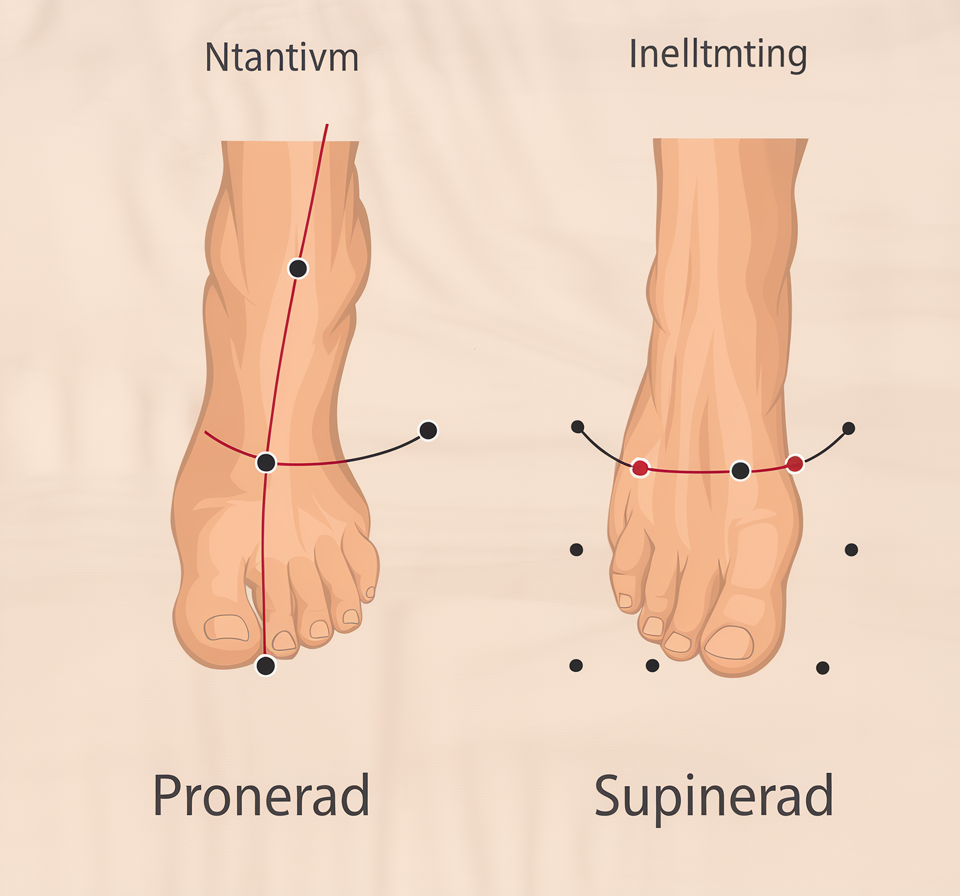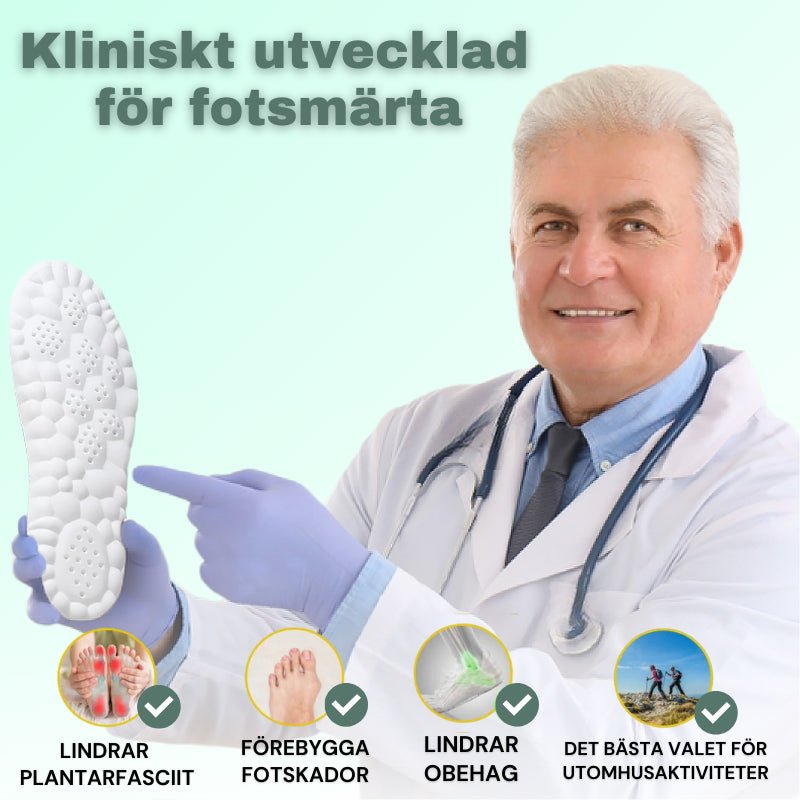Pronation in the Foot: Causes, Symptoms, and Treatment

Pronation of the foot is a natural movement, but overpronation can lead to various problems. This article reviews what pronation is, symptoms of overpronation, and how to treat the problem.
What is pronation and how does it affect your foot?
Pronation is a natural movement where the foot rotates inward when walking or running. Normal pronation helps absorb shock and distribute the load. Overpronation occurs when the foot rotates inward too much, which can lead to various problems.
When you walk or run, your foot should normally pronate and supinate - that is, move inward and outward - to absorb shock and adapt to the ground. With slight pronation, the foot rotates inward in a balanced way, which helps distribute body weight evenly.
In excessive pronation, also known as overpronation, the foot rolls inward too much, meaning that the foot and ankle tend to roll inward, placing abnormal stress on the ankle and lower leg. This often occurs in people with flat feet (pes planus) where the arch of the foot has a sunken longitudinal arch, causing the body weight to be placed on the inside of the foot.
Common symptoms of overpronation and pronation-related foot problems
Common signs of overpronation include:
- Pain on the inside of the knee
- Periostitis in the lower leg
- Heel spur or plantar fasciitis
- Instability of the kneecap
- Faster wear on the inside of the shoe soles
- Crooked feet or inward-turned ankles
- Pain in the feet, especially after prolonged standing or walking
- Hip and back problems due to poor posture
- Fatigue in the feet
- The outside of the heel wears out faster on the shoes
Overpronation often accompanies flat feet, which means the foot has a sunken longitudinal arch. This can be a specific medical foot problem that requires correction to avoid long-term problems.
Why does overpronation occur? Common causes and risk factors
Overpronation can be caused by several factors:
- Low arches or flat feet, where the arch of the foot can collapse under load
- Weak muscles in the foot and lower leg that cannot stabilize the ankle sufficiently
- Genetic factors that affect the structure of the foot
- Excess weight that increases the load on the feet
- Incorrect shoe use without sufficient support
- Training on hard surfaces without sufficient shock absorption
- Congenital structural problems with the feet
- Poor technique when running or walking
- Previous injuries that affect the biomechanics of the foot
The degree of pronation varies from person to person, and some people naturally have a higher level of pronation than others. To find out if you overpronate, you can examine the wear and tear on your shoes or consult a podiatrist for a professional assessment, especially if you are experiencing foot overload .
How do you know if you pronate? Diagnosis methods and treatment for overpronation
Overpronation means that your foot rolls inward more than normal when you walk or run. This can lead to imbalances in the body and pain in the feet, knees, or hips. Early diagnosis and proper treatment can reduce strain and improve foot stability.
Gait analysis
A gait analysis is performed to assess how the foot moves with each step.
Recommended treatment: Customized shoes with extra support that stabilize the arch of the foot.
4D insoles offer advanced shock absorption that adapts to your foot dynamics.
Shoe wear
Uneven wear on the soles of your shoes can be a clear sign of overpronation.
Recommended treatment: Physical therapy and strength training to strengthen the muscles of the foot.
4D support insoles are adjustable in size and shape, providing individual comfort and correction.
Footprint test
A footprint test shows how weight is distributed across the foot.
Recommended treatment: Customized insoles that support the arch of the foot.
4D support insoles use 4D cloud technology for optimal comfort and relief throughout the day.
X-ray if necessary
In case of prolonged discomfort, an X-ray can rule out skeletal or joint problems.
Recommended treatment: Taping of the foot to reduce overpronation.
4D support insoles also provide an acupressure-like massage effect, which stimulates circulation and relieves fatigue.
Signs of overpronation
Pain in the arch, heel, or inside of the foot
Uneven wear on shoes
Unstable feeling in the ankle
Tiredness in the legs and knees after long walks
If you experience these symptoms, 4D support insoles can provide quick relief and improved balance with every step.

4D support insoles – an effective shoe insert for problems with pronation and supination
4D support insoles from Komforten offer several benefits for people with overpronation:
- Advanced cushioning technology helps absorb shock and reduces stress on the foot
- Adjustable size for optimal fit in different shoe models
- 4D cloud technology provides exceptional comfort and support where the foot needs it most
- Acupressure massage that promotes blood circulation and reduces fatigue in the feet
- U-shaped heel counter for stability and pressure distribution that prevents the foot from rotating too much inward
- Longitudinal arch support helps prevent arch collapse
- Helps correct excessive pronation by providing proper support under the inside of the foot
Unlike many other inserts, the 4D support insoles are designed to provide support while being comfortable to wear all day, making them a practical option for people who need to correct their pronation.
Buy nowSummary: How to deal with foot pronation problems
Overpronation is a common problem that can cause various problems in the feet, legs and back. By using the right shoes, supporting insoles such as 4D insoles, and performing strengthening exercises, many people can effectively manage and prevent problems related to overpronation. It is important to consult a podiatrist or orthopedist for a correct diagnosis and individual treatment plan.
Understanding how your foot moves and your level of pronation is the first step towards managing any potential problems and preventing future problems. With the right support and correction, many people can continue to be active without causing pain or discomfort – especially with related conditions like heel spurs .
Frequently Asked Questions (FAQ)
How do I know if I have overpronation?
Look at your shoes - if they are more worn on the inside, it could indicate overpronation. A podiatrist can do a more thorough analysis by studying your gait and footprints.
Can overpronation cause problems in other parts of the body?
Yes, overpronation can affect the knees, hips, and back due to improper loading. The unnatural rotation of the foot can change the posture of the entire body and lead to pain in multiple joints.
How often do I need to replace my 4D insoles?
It depends on use, but generally it is recommended to replace every 6-12 months for optimal effect. If the insoles start to lose their shape or support properties, they should be replaced sooner.
Can I use 4D insoles in all types of shoes?
D-shoes are designed to fit most shoe styles, but always check the fit. They work best in shoes with enough room and removable insoles.
How long does it take before I notice a difference with 4D insoles?
Many experience immediate comfort, but the full effect on any discomfort may take a few weeks while the body adjusts to the new, more correct foot position.

